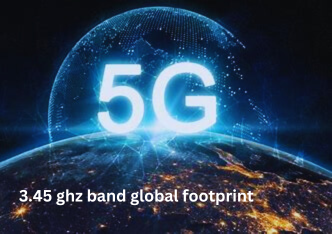Overview of the worldwide 3.45 ghz band global footprint
With the globe rushing toward a more connected future, 3.45 ghz bandban has become an essential part of 5G network development. Because of its exceptional value in balancing capacity and coverage, this mid-band spectrum is crucial for next-generation wireless communication. Let’s examine more closely how the 3.45 GHz band is being adopted and used in various places. The global footprint of the 3.45 GHz spectrum is discussed in this article.
Overview of the world’s frequencies allocated:
The frequency range of the 3.45 GHz band is 3.4 GHz to 3.8 GHz, with regional variations in the exact allotments. This band’s center, which is approximately 3.45 GHz, is essential for mobile broadband applications.
Adoption in the Region:
United States:
Auction and Allocation of Spectrum:
The C-spectrum, or 3.45–3.55 GHz spectrum, will be put up for auction by the Federal Communications Commission (FCC) in July 2021 in order to fund 5G services. 100 MHz of spectrum was up for grabs in this auction, which is sometimes called Auction 110.
Major mobile carriers and other service providers want to use the spectrum to improve their 5G networks. The intense competition at the auction was a reflection of the strong demand for mid-band spectrum.
Utilization and Deployment:
To take advantage of 5G’s capacity and performance advantages, major carriers like Verizon, AT&T, and T-Mobile USA have acquired spectrum in this band and are aggressively developing 5G infrastructure.
With this band, the U.S. has concentrated on increasing 5G coverage in both urban and rural areas with the goal of lowering latency and enhancing overall network performance.
In order to encourage the use of 5G for mobile and fixed wireless broadband services, the Federal Communications Commission (FCC) put up 3.45–3.55 GHz spectrum for sale in 2021.
Europe:
Germany:
In 2019, the 3.4–3.8 GHz band was put up for auction by the Federal Network Agency (Bundesnetzagentur). Major carriers got large sections of this spectrum, including Telefónica, Vodafone, and Deutsche Telekom.
United Kingdom:
Operators like EE, Vodafone, and Three are using the spectrum from the 2021 auction held by the UK’s Ofcom to improve their 5G networks.
France:
In 2020, the 3.4-3.8 GHz band was put up for auction by the French regulator ARCEP, with major firms like Orange, SFR, Bouygues Telecom, and Free acquiring spectrum to improve their 5G capabilities.
To encourage uniform use and foster network growth and innovation, the European Commission has earmarked the 3.4–3.8 GHz range for 5G throughout its member states.
Asia-Pacific:
With differing degrees of spectrum availability and regulatory methods, nations like Australia and Japan are also assigning portions of the 3.4–3.6 GHz range for 5G services.
China:
The country is setting the global standard for 5G implementation, and a major factor in its development is the 3.45 GHz band. The 3.3–3.6 GHz band is being heavily utilized by the nation’s leading telecom providers, such as China Mobile, China Telecom, and China Unicom, to improve their 5G networks. China has already deployed millions of base stations, and its 5G infrastructure is growing quickly.
Japan:
The country has determined that the 3.4–3.6 GHz band is essential for the deployment of 5G. Major operators like as NTT Docomo, KDDI, and SoftBank have been allotted this spectrum by the Ministry of Internal Affairs and Communications (MIC). With the goal of supporting upcoming technologies and offering fast connectivity, these businesses are aggressively building out 5G networks.
Australia:
In 2021, the 3.41-3.71 GHz band was put up for auction by the Australian Communications and Media Authority (ACMA) in an effort to promote 5G services. To develop their 5G networks, major Australian carriers, including TPG Telecom, Optus, and Telstra, purchased spectrum.
Japan
South Korea:
The 3.4–3.6 GHz band has been set aside for 5G services by South Korea, which is leading the way in 5G implementation. Utilizing this frequency, Korean carriers KT, LG Uplus, and SK Telecom have been able to put out massive 5G networks.
Africa and the Middle East:
Middle East:
3.4–3.8 GHz is also being adopted by nations like the United Arab Emirates and Saudi Arabia for 5G. These areas’ regulators are in the process of putting this frequency up for auction in order to facilitate the rollout of cutting-edge wireless networks.
Africa:
The distribution of spectrum in Africa differs greatly throughout nations. To enhance connection and facilitate the digital transition, certain countries are starting to investigate the 3.4–3.8 GHz range for 5G. However, because to problems with infrastructure and funding, adoption is frequently slower.
Worldwide Harmonization:

As part of its global spectrum management initiatives, the International Telecommunication Union (ITU) has endorsed the usage of the 3.4–3.8 GHz range for 5G. This harmonization contributes to the seamless cross-border operation of networks and devices.
Main Advantages:
- Improved Capacity: A decent compromise between capacity and coverage is offered by the 3.45 GHz band. When compared to lower frequency bands, it offers superior coverage than higher frequency millimeter-wave bands and supports larger data rates and enhanced network capacity.
- Reduced Latency: 5G applications that require real-time communication, such industrial automation and driverless cars, benefit from the reduction of latency that comes with using this band.
- Growth of Broadband: Expanding internet access, especially in underserved areas, requires the use of the 3.45 GHz band. In both urban and rural settings, it enhances connectivity.
Challenges:
Problems with Interference: Interference may be an issue because the 3.45 GHz band is utilized for many things, including as weather radar in some areas and satellite services. Coordination and mitigation techniques that work are crucial.
Disparities in Regulation: International harmonization and device compatibility may face difficulties due to differences in spectrum allocation and regulatory strategies among nations.
Investment in Infrastructure: It can be difficult to deploy 5G infrastructure in some areas since it involves a large investment in new technologies and network upgrades in the 3.45 GHz range.
Towards the Future:
It is anticipated that the 3.45 GHz band will be crucial to the development of next-generation wireless technologies as well as the ongoing rollout of 5G networks. As more nations implement comparable spectrum allocation policies to promote sophisticated communication services, its global footprint is anticipated to increase. To fully reap the benefits of this important frequency range, international cooperation and regulatory harmonization are essential.
FAQs Regarding the Global Coverage of the 3.45 GHz Band:
Q: Why is 5G dependent on the 3.45 GHz band?
A: There is a frequency sweet spot in the 3.45 GHz range. Higher data rates and more dependable connections are made possible by its excellent coverage and capacity balance, which eliminates the need for the substantial infrastructure required for higher-frequency bands. It is therefore perfect for suburban and urban settings.
Q. What is the difference between the 3.45 GHz band and other 5G bands?
A: The data rates and capacity of the 3.45 GHz band are higher than those of low-band frequencies (below 1 GHz). Although it can’t reach the extremely high speeds of mm Wave bands (beyond 24 GHz), it can cover a wider area with fewer base stations, which makes it more affordable and useful for the global rollout of 5G.
Q: Does the 3.45 GHz band present any difficulties?
A: Just like any technology, there are unique difficulties in implementing 5G in the 3.45 GHz range. Managing interference is essential, particularly in places with a high population density. Furthermore, network operators may have to invest in expensive and time-consuming new hardware and infrastructure.
Q. What are the potential advantages for consumers using the 3.45 GHz band?
A: Faster upload and download speeds, lower latency, and more dependable connections are what customers can anticipate. This means that video streaming will run more smoothly, online gaming will be more enjoyable, and smart home appliances and Internet of Things apps will operate better.
Q. What effects does the 3.45 GHz spectrum have on non-telecommunications industries?
A. Aside from improving mobile broadband, the 3.45 GHz spectrum is expected to transform a number of sectors. Telemedicine and remote surgery can help the healthcare industry, and manufacturers can use it to automate processes and monitor them in real time. Numerous and revolutionary uses are possible.
Conclusion:
Unquestionably, a key component in the global deployment of 5G technology is the 3.45 GHz band. Because of its well-balanced characteristics, it is a strong contender to fulfill the 3G promises of increased speed, less latency, and dependable connections. We can anticipate major improvements in communicating and interacting with the digital world as long as nations accept and use this frequency. Thus, keep a watch on the 3.45 GHz band as it is poised to revolutionize the technology industry.
For more information visit our Homepage.


